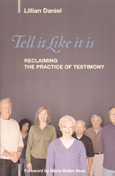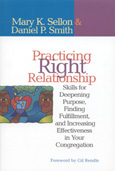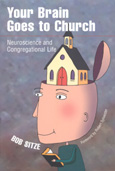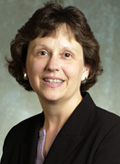“What do you mean, why do we sit where we do?” The group stared blankly at Pastor Mark. “If the sermon was only about interacting with the preacher,” Pastor Mark answered thoughtfully, “you’d all be sitting in the first few pews, right in front of the pulpit. So why do people sit in the back or in the balcony? Why do some members of our congregation sit together all bunched up, while others spread out and refuse to slide over, even when the place is packed? I think it has something to do with the way people interact with one another in worship.”
Fred interrupted, “Isn’t interacting with the congregation during the sermon something you are supposed to do?” Everyone laughed, but Pastor Mark wasn’t giving in. “Audrey sits front and center, her eyes fixed on the pulpit, but Drew seems more interested in having a good view of the cross and stained glass than of me. Eleanor tells us that her Sunday school class looks everywhere except at the pulpit, and kids aren’t the only ones.” Looking over at Brian, Pastor Mark continued, “I like to look up at Brian in the balcony and catch him checking out the congregation during the sermon. And Eleanor, I’d like to be in on the running commentary that you and the church ladies are having in the back. So why do you sit where you do?”
Asking about where people choose to sit during the sermon and inviting them to become aware of the implications for that choice may at first appear to be a silly exercise, because it is not something most people ordinarily think about. Yet, reflecting on how people position themselves in relation to others during the sermon, and indeed throughout the entire worship service, provides important clues to how a congregation understands itself as a faith community and an expression of the church. Human behavior communicates meaning. Carefully observing and interpreting how people relate during an event as central to a congregation’s life as the Sunday sermon provides insights into the character of their common life. People’s interactions reveal how they order their world. Whether the nature of a congregation’s common life is explicitly declared in a mission statement and consciously nurtured by its leaders or unconsciously expressed in the way the congregation worships together, the kind of faith community a congregation is has important implications for its mission. For example, congregations that desire to grow frequently have difficulty doing so, because having more members will change the way members interact, how decisions get made, and how the congregation understands itself as an expression of the church. Asking people to observe how they relate to other members of the congregation during important moments in their shared life, especially worship and preaching, can help congregations understand how they must change if they are to grow.
Yet, becoming aware of and reflecting on an interaction as simple as where we sit in church, and teasing out the implications of a congregation’s seating arrangement, is not easy. First, everyone in a congregation rarely chooses their seats for the same reason, although some worshipers may appear to have made the same choice. Parents with energetic children choose the last pew for a different reason than the grieving widow sitting alone. But both make a decision about how they will interact with the congregation. Second, as people become conscious of why they sit where they do and how they act in worship, they may alter their behavior, particularly if they are embarrassed by what they are doing. Pastor Mark’s comment to Eleanor might stop the church ladies’ running commentary, at least for a while. Moreover, Christian worship is designed, in part, to alter people’s behavior by bringing it more in step with the congregation’s understanding of discipleship and Christian living. People may behave a certain way in church precisely because they are in church. A congregation that warmly huddles together at the coffee hour may sit straight, silent, and spread out during the worship service, because members have been taught that a quiet, formal disposition is appropriate for Christian worship. Finally, we need to be careful how we interpret others’ behavior. Parishioners who, upon entering church, chat with those around them may intend to engage others in order to worship more fully as the body of Christ. However, they may be perceived by others as casual and even irreverent. Someone who closes his eyes and lowers his head during a sermon may be perceived as sleeping when he is, in fact, seriously concentrating. For members, a congregation sitting close together is warm and intimate; for visitors, the congregation may feel closed. Mindful of these cautions, we can be aware of and attempt to interpret how we interact with the congregation during worship and preaching by reflecting on why we choose to sit where we do.
Why observe where we sit during the sermon as opposed to some other aspect of congregational life, like the coffee hour? As part of the worship service, preaching is an activity in which we claim to be most aware of and committed to our identity as a faith community and the body of Christ. As I described in chapter 4, we all have expectations about how sermons ought to connect with us individually. Most Christians also hope preaching will cause or at least help something positive to happen in the life of the congregation as well. For example, Charles Campbell, who teaches preaching at Columbia Theological Seminary in Decatur, Georgia, argues that the purpose of preaching is to build up the community of faith as “a people who practice the way of God, as embodied in Jesus Christ, in and for the world.”1 Campbell observes that in the Sermon on the Mount, Jesus seeks to constitute the community of the disciples who will embody his way of life in the world. In this community, reconciliation takes priority over vengeance, women are not treated as objects or property, and love of enemies and nonviolent resistance replace violent domination. In the community that Jesus establishes, people do not use religious practices to build themselves up while tearing others down, and the desire for wealth is not the driving force of life.2
1. Campbell, “Resisting the Powers,” in Childers, The Purposes of Preaching, 24.
2. Ibid., 33–34.
Adapted from When God Speak’s Through You: How Faith Convictions Shape Preaching and Mission, copyright © 2008 by the Alban Institute. All rights reserved.
Copyright © 2013, the Alban Institute. All rights reserved. We encourage you to share Alban Weekly articles with your congregation. We gladly allow permission to reprint articles from the Alban Weekly for one-time use by congregations and their leaders when the material is offered free of charge. All we ask is that you write to us at alban@div.duke.edu and let us know how Alban Weekly is making an impact in your congregation. If you would like to use any other Alban material, or if your intended use of Alban Weekly does not fall within this scope, please submit our reprint permission request form.

When God Speak’s Through You: How Faith Convictions Shape Preaching and Mission
Craig A. Satterlee
“Holy and active listening” means listening openly and attentively to one another with the expectation that God will speak in and through the conversation. In When God Speaks Through You, homiletics professor Craig Satterlee helps preachers and their congregations learn to listen to one another with such grace.

Tell it Like it is
Lillian Daniel
When a study group at the seemingly traditional Church of the Redeemer in New Haven, Connecticut, read about the practice of testimony, members approached the descriptions of people sharing their faith as if they were reading an anthropology article—an intriguing account about what other people from some entirely different culture did.During the 2000 Lenten season, however, the congregation slowly began exploring the practice of testimony—a practice that would eventually revitalize their worship and transform their congregational culture. In Tell It Like It Is, Lillian Daniel, pastor of the congregation, describes how the practice of testimony strengthened lay leadership, fostered more intimate community, and drew the congregation closer to God.
 Practicing Right Relationship: Skills for Deepening Purpose, Finding Fulfillment, and Increasing Effectiveness in Your Congregation
Practicing Right Relationship: Skills for Deepening Purpose, Finding Fulfillment, and Increasing Effectiveness in Your Congregation
Mary K. Sellon, Daniel P. Smith
Why is it that some pastors flourish wherever they go, while others with superior theological and practical training continually fail? Why do some insignificant events end up touching people in significant ways? Why do people leave churches with vibrant and exciting programs while others remain loyal to churches that seem to have very little to offer? What makes the difference? In a book that is both profound and practical, Mary Sellon and Daniel Smith make the case that the health of churches and synagogues depends on congregations learning how to live out love in “right relationships.”
 Your Brain Goes to Church: Neuroscience and Congregational Life
Your Brain Goes to Church: Neuroscience and Congregational Life
Bob Sitze
Emerging discoveries in brain science are sparking new areas of research as cutting-edge educators and psychologists are asking, “What can we learn from brain science about how we function in the world?” In Your Brain Goes to Church, ever-provocative author Bob Sitze joins the conversation with a new question: What does the human brain have to do with the beliefs, practices, and structures of congregations?
 Conflict in Your Congregation: The Basics
Conflict in Your Congregation: The Basics
Leader: Susan Nienaber, Alban Senior Consultant and Author
Location: Epworth-by-the-Sea, St. Simon’s Island, GA
Date: February 4 – 6, 2013 – Part of an Alban Cluster of Learning Events
Celebrate Alban’s 40th Anniversary
“40 Years of Innovation”
Register for any 2014 Alban event
before December 31, 2013 and save $40.
